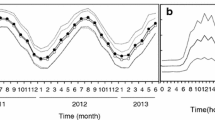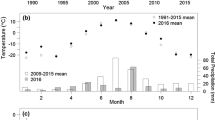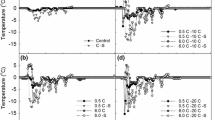Abstract
Alpine dwarf shrub communities are phenologically linked with snowmelt timing, so early spring exposure may increase risk of freezing damage during early development, and consequently reduce seasonal growth. We examined whether environmental factors (duration of snow cover, elevation) influenced size and the vulnerability of shrubs to spring freezing along elevational gradients and snow microhabitats by modelling the past frequency of spring freezing events. We sampled biomass and measured the size of Salix herbacea, Vaccinium myrtillus, Vaccinium uliginosum and Loiseleuria procumbens in late spring. Leaves were exposed to freezing temperatures to determine the temperature at which 50 % of specimens are killed for each species and sampling site. By linking site snowmelt and temperatures to long-term climate measurements, we extrapolated the frequency of spring freezing events at each elevation, snow microhabitat and per species over 37 years. Snowmelt timing was significantly driven by microhabitat effects, but was independent of elevation. Shrub growth was neither enhanced nor reduced by earlier snowmelt, but decreased with elevation. Freezing resistance was strongly species dependent, and did not differ along the elevation or snowmelt gradient. Microclimate extrapolation suggested that potentially lethal freezing events (in May and June) occurred for three of the four species examined. Freezing events never occurred on late snow beds, and increased in frequency with earlier snowmelt and higher elevation. Extrapolated freezing events showed a slight, non-significant increase over the 37-year record. We suggest that earlier snowmelt does not enhance growth in four dominant alpine shrubs, but increases the risk of lethal spring freezing exposure for less freezing-resistant species.




Similar content being viewed by others
References
Auffret AG, Meineri E, Bruun HH, Ejrnæs R, Graae BJ (2010) Ontogenetic niche shifts in three Vaccinium species on a sub-alpine mountain side. Plant Ecol Div 3:131–139
Bannister P, Maegli T, Dickinson KJM, Halloy SRP, Knight A, Lord JM, Mark AF, Spencer KL (2005) Will loss of snow cover during climatic warming expose New Zealand alpine plants to increased frost damage? Oecologia 144:245–256
Barbeito I, Dawes MA, Rixen C, Senn J, Bebi P (2012) Factors driving mortality and growth at treeline: a 30-year experiment of 92,000 conifers. Ecology 93:389–401
Bokhorst S, Bjerke JW, Bowles FW, Melillo J, Callaghan TV, Phoenix GK (2008) Impacts of extreme winter warming in the sub-Arctic: growing season responses of dwarf shrub heathland. Glob Change Biol 14:2603–2612
Bykova O, Sage RF (2012) Winter cold tolerance and the geographic range separation of Bromus tectorum and Bromus rubens, two severe invasive species in North America. Glob Change Biol 18:3654–3663
Elmendorf SC, Henry GHR, Hollister RD, Bjork RG, Boulanger-Lapointe N, Cooper EJ, Cornelissen JHC, Day TA, Dorrepaal E, Elumeeva TG, Gill M, Gould WA, Harte J, Hik DS, Hofgaard A, Johnson DR, Johnstone JF, Jonsdottir IS, Jorgenson JC, Klanderud K, Klein JA, Koh S, Kudo G, Lara M, Levesque E, Magnusson B, May JL, Mercado-Diaz JA, Michelsen A, Molau U, Myers-Smith IH, Oberbauer SF, Onipchenko VG, Rixen C, Martin Schmidt N, Shaver GR, Spasojevic MJ, Porhallsdottir PE, Tolvanen A, Troxler T, Tweedie CE, Villareal S, Wahren C-H, Walker X, Webber PJ, Welker JM, Wipf S (2012) Plot-scale evidence of tundra vegetation change and links to recent summer warming. Nature Clim Change 2:453–457
Gerdol R, Siffi C, Iacumin P, Gualmini M, Tomaselli M (2013) Advanced snowmelt affects vegetative growth and sexual reproduction of Vaccinium myrtillus in a sub-alpine heath. J Veg Sci 24:569–579
Heide OM (2001) Photoperiodic control of dormancy in Sedum telephium and some other herbaceous perennial plants. Physiol Plant 113:332–337
Hudson JMG, Henry GHR, Cornwell WK (2011) Taller and larger: shifts in Arctic tundra leaf traits after 16 years of experimental warming. Glob Change Biol 17:1013–1021
Inouye DW (2000) The ecological and evolutionary significance of frost in the context of climate change. Ecol Lett 3:457–463
Inouye DW (2008) Effects of climate change on phenology, frost damage, and floral abundance of montane wildflowers. Ecology 89:353–362
IPCC (eds) (2007) Climate change 2007: the physical science basis. Contribution of Working Group I to the fourth assessment report of the Intergovernmental Panel on Climate Change. Cambridge Univ. Press
Jordan DN, Smith WK (1995) Microclimate factors influencing the frequency and duration of growth season frost for subalpine plants. Agric For Meteorol 77:17–30
Keller F, Körner C (2003) The role of photoperiodism in alpine plant development. Arct Antarct Alp Res 35:361–368
Kirchner M, Faus-Kessler T, Jakobi G, Leuchner M, Ries L, Scheel HE, Suppan P (2013) Altitudinal temperature lapse rates in an Alpine valley: trends and the influence of season and weather patterns. Int J Climatol 33:539–555
Kollas C (2013) Bioclimate and reproductive potential at the cold limit of European deciduous tree species. PhD Thesis, University of Basel
Körner C (2003) Alpine plant life: functional plant ecology of high mountain ecosystems. Springer, Heidelberg Berlin New York
Körner C (2012) Treelines will be understood once the functional difference between a tree and a shrub is. Ambio 41:197–206
Körner C, Larcher W (1988) Plant life in climate climates. Symp Soc Exp Biol 42:25–57
Kudo G, Hirao AS (2006) Habitat-specific responses in the flowering phenology and seed set of alpine plants to climate variation: implications for global-change impacts. Popul Ecol 48:49–58
Kullman L (2002) Rapid recent range-margin rise of tree and shrub species in the Swedish Scandes. J Ecol 90:68–77
Ladinig U, Hacker J, Neuner G, Wagner J (2013) How endangered is sexual reproduction of high-mountain plants by summer frosts? Frost resistance, frequency of frost events and risk assessment. Oecologia 171:743–760
Larcher W, Kainmüller C, Wagner J (2003) Physiological plant ecology: ecophysiology and stress physiology of functional groups. Springer, Heidelberg Berlin New York
Larcher W, Kainmüller C, Wagner J (2010) Survival types of high mountain plants under extreme temperatures. Flora 205:3–18
Lenz A, Hoch G, Vitasse Y, Körner C (2013) European deciduous trees exhibit similar safety margins against damage by spring freeze events along elevational gradients. New Phytol. 200:1166–1175
Mallik AU, Wdowiak JV, Cooper EJ (2011) Growth and reproductive responses of Cassiope tetragona, a circumpolar evergreen shrub, to experimentally delayed snowmelt. Arct Antarct Alp Res 43:404–409
Márquez EJ, Rada F, Fariñas MR (2007) Freezing tolerance in grasses along an altitudinal gradient in the Venezuelan Andes. Oecologia 150:393–397
Martin M, Gavazov K, Körner C, Hättenschwiler S, Rixen C (2010) Reduced early growing season freezing resistance in alpine treeline plants under elevated atmospheric CO2. Glob Change Biol 16:1057–1070
Milbau A, Graae BJ, Shevtsova A, Nijs I (2009) Effects of a warmer climate on seed germination in the subarctic. Ann Bot 104:287–296
Molau U (1997) Phenology and reproductive success in arctic plants: susceptibility to climate change. In: Oechel W, Callaghan T, Gilmanov T, Holten J, Maxwell B, Molau U, Sveinbjörnsson B (eds) Global change and arctic terrestrial ecosystems. Springer, New York, pp 153–170
Neuner G, Ambach D, Buchner O (1999) Readiness to frost harden during the dehardening period measured in situ in leaves of Rhododendron ferrugineum L. at the alpine timberline. Flora 194:289–296
Prieto P, Peñuelas J, Niinemets U, Ogaya R, Schmidt IK, Beier C, Tietema A, Sowerby A, Emmett BA, Láng EK, Kröel-Dulay G, Lhotsky B, Cesaraccio C, Pellizzaro G, de Dato G, Sirca C, Estiarte M (2009) Changes in the onset of spring growth in shrubland species in response to experimental warming along a north–south gradient in Europe. Glob Ecol Biogeogr 18:473–484
Rixen C, Schwoerer C, Wipf S (2010) Winter climate change at different temporal scales in Vaccinium myrtillus, an Arctic and alpine dwarf shrub. Polar Res 29:85–94
Rixen C, Dawes MA, Wipf S, Hagedorn F (2012) Evidence of enhanced freezing damage in treeline plants during six years of CO2 enrichment and soil warming. Oikos 121:1532–1543
Sakai A, Larcher W (1987) Frost survival of plants: responses and adaptation to freezing stress. Springer, Berlin Heidelberg New York
Sakai A, Matsui K, Kabeya D, Sakai S (2003) Altitudinal variation in lifetime growth trajectory and reproductive schedule of a sub-alpine conifer, Abies mariesii. Evol Ecol Res 5:671–689
Schirmer M, Wirz V, Clifton A, Lehning M (2011) Persistence in intra-annual snow depth distribution. 1. Measurements and topographic control. Water Res Res 47
Sierra-Almeida A, Cavieres LA (2012) Summer freezing resistance of high-elevation plant species changes with ontogeny. Environ Exp Bot 80:10–15
Sierra-Almeida A, Cavieres LA, Bravo LA (2009) Freezing resistance varies within the growing season and with elevation in high-Andean species of central Chile. New Phytol 182:461–469
Sklenar P, Kucerova A, Macek P, Mackova J (2010) Does plant height determine the freezing resistance in the páramo plants? Aust Ecol 35:929–934
Sundqvist MK, Bjork RG, Molau U (2008) Establishment of boreal forest species in alpine dwarf-shrub heath in subarctic Sweden. Plant Ecol Div 1:67–75
Taschler D, Neuner G (2004) Summer frost resistance and freezing patterns measured in situ in leaves of major alpine plant growth forms in relation to their upper distribution boundary. Plant Cell Environ 27:737–746
Venn SE, Morgan JW, Lord JM (2013) Foliar freezing resistance of Australian alpine plants over the growing season. Aust Ecol 38:152–161
Wheeler JA, Hermanutz L, Marino PM (2011) Feathermoss seedbeds facilitate black spruce seedling recruitment in the forest-tundra ecotone (Labrador, Canada). Oikos 120:1263–1271
Wijk S (1986) Performance of Salix herbacea in an alpine snowbed gradient. J Ecol 74:675–684
Wipf S (2010) Phenology, growth, and fecundity of eight subarctic tundra species in response to snowmelt manipulations. Plant Ecol 207:53–66
Wipf S, Rixen C (2010) A review of snow manipulation experiments in Arctic and alpine tundra ecosystems. Polar Res 29:95–109
Wipf S, Stoeckli V, Bebi P (2009) Winter climate change in alpine tundra: plant responses to changes in snow depth and snowmelt timing. Clim Change 94:105–121
Acknowledgments
We wish to acknowledge and thank Armando Lenz (University of Basel) for assistance provided during the laboratory freezing experiments, Felix Prahl and Yves Bötsch for their help during field sampling, Guenther Klonner for data-extraction assistance, and two anonymous reviews for improvements to the manuscript. This project was made possible by funding from the Swiss National Science Foundation (Grant CRSI33_130409/1).
Author information
Authors and Affiliations
Corresponding author
Additional information
Communicated by Kouki Hikosaka.
Electronic supplementary material
Below is the link to the electronic supplementary material.
Rights and permissions
About this article
Cite this article
Wheeler, J.A., Hoch, G., Cortés, A.J. et al. Increased spring freezing vulnerability for alpine shrubs under early snowmelt. Oecologia 175, 219–229 (2014). https://doi.org/10.1007/s00442-013-2872-8
Received:
Accepted:
Published:
Issue Date:
DOI: https://doi.org/10.1007/s00442-013-2872-8




